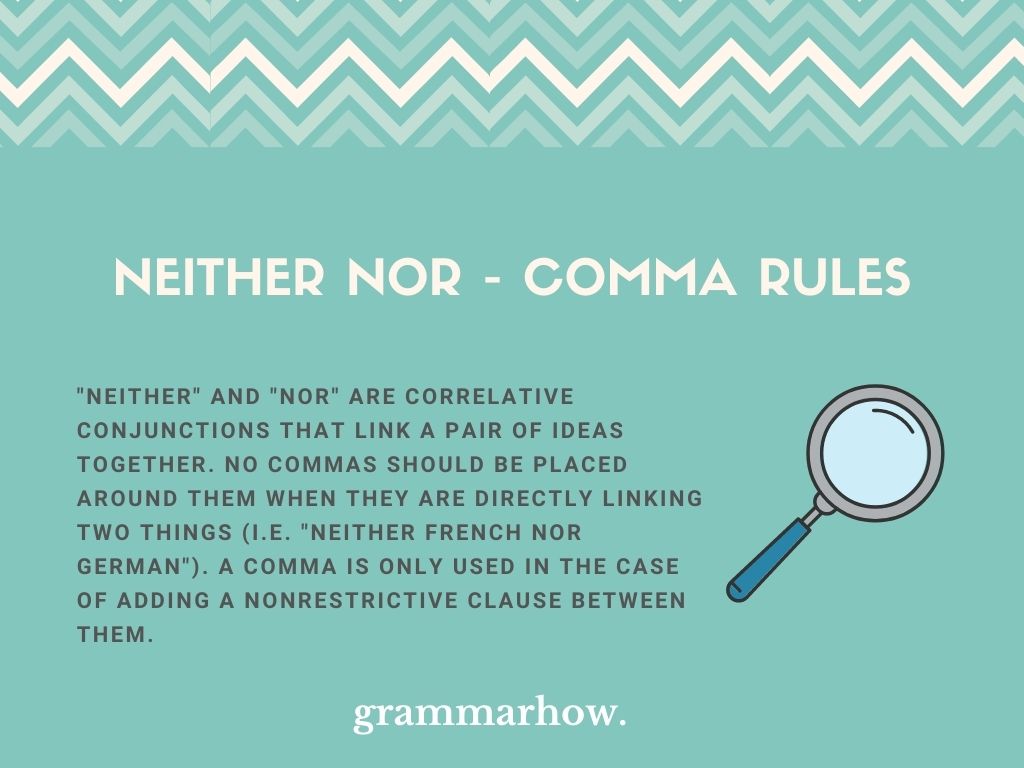“Neither” and “nor” are correlative conjunctions that only operate correctly when they are used together. It would help to know what kind of comma rules are used with these words. This article will show you how they work.
Neither Nor – Comma Rules
“Neither” and “nor” are correlative conjunctions that link a pair of ideas together. No commas should be placed around them when they are directly linking two things (i.e. “neither French nor German”). A comma is only used in the case of adding a nonrestrictive clause between them.

For the most part, you should never worry about using commas with words like these. Correlative conjunctions always depend on each other to link similar ideas in a sentence.
You might also come across other correlative linkers like “either… or” and “not only… but also.” All of these follow the same ideas that mean commas aren’t required with them.
It’s better suited to write them like so:
- Neither Jack nor Michael wanted to take part in the competition.
Including a comma before “nor” would segment the link between the two names. It’s not something that you should do, as it removes the need for “neither” and “nor” to correlate with each other.
When to Not Use a Comma
You should not use a comma in most cases when “neither” and “nor” are used. Commas will stop them from linking to each other, which removes their meaning from the sentence. You should always keep “neither a nor b” without any punctuation to make a clear connection.
Some people believe that a comma should come before “nor” because it creates a list. However, it is not a list in the same sense that you’re used to.
Sure, if you’re listing a group of things off, then you would need commas:
- Apples, pears, oranges, and bananas
However, if you are using “neither” and “nor,” you are not listing things. Instead, you are creating a common, negative correlation between multiple items. Commas would only interrupt this connection.
- Neither apples nor pears nor oranges nor bananas
Also, there is no limit to the number of objects you can use with “neither” and “nor.” Ideally, you should stick with only two items because it’s the most expected variation. If you have more to include, though, there are no rules that tell you that you can’t.
- Neither apples nor pears will be included on this menu. I hate them both.
- I will represent neither him nor her. I believe they are both in the wrong, and I don’t appreciate that.
- Neither you nor she is correct about this. I’ll be happy to help you understand where you went wrong, though.
- Neither my family nor hers decided to come along with us on this trip. It’s quite sad, honestly.
- Neither you nor I can get what we want from this event!
- I will do neither that nor this. I don’t see much of a reason for me to do either!
When to Use a Comma
You should only use a comma when a nonrestrictive clause comes directly before “nor.” This clause is used when you want to add more information to one of the objects (the one that comes after “neither”). It helps to establish a reason why there is a correlation.
The nonrestrictive clause is always a parenthetical element. It is something that can be placed inside a sentence to add further information. It can just as easily be removed and still allow the sentence to make sense.
- Neither John, who was ill again, nor Tim could have it to the party that day.
- Neither apples, which I despise, nor bananas were included on the menu. Sorry about that.
- I will stand for neither him, because of his morals, nor her, because of her idiocy.
- Neither that, which is irrelevant here, nor this are things that I want to dedicate any more of my time to.
- Neither of my parents, which saddens me, nor my extended family members cared enough to come and watch my play.
- Neither Michelle, who had her reasons, nor Tara thought that it was a good idea to call me when I had that accident.
Final Thoughts
“Neither” and “nor” do not need commas in standard English sentences. They correlate with each other, allowing you to link ideas that you have negative views on. You would only ever include a comma when a parenthetical element is included after “neither” but before “nor.”
You may also like:
Neither A Nor B vs. A and B Are Not – Difference Explained
Can You Use “Nor” Without “Neither”? (Helpful Examples)

Martin holds a Master’s degree in Finance and International Business. He has six years of experience in professional communication with clients, executives, and colleagues. Furthermore, he has teaching experience from Aarhus University. Martin has been featured as an expert in communication and teaching on Forbes and Shopify. Read more about Martin here.
